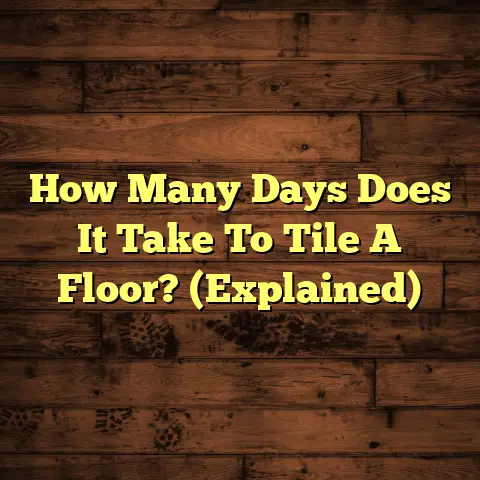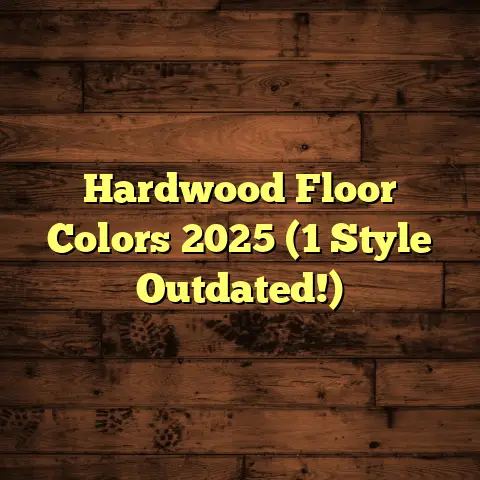Clean Stained Terrazzo Floors? (5 Fixes Now!)
Terrazzo floors aren’t just floors; they’re
statements.
And lately, terrazzo is making a
huge comeback!
Architects are loving it.
Just last year, the “Urban Oasis” project by
Studio Verde won the “Innovative Use of
Materials” award at the International Design
Awards, and guess what?
Terrazzo was the star.
But here’s the thing: life happens, and sometimes, those beautiful floors get stained.
Don’t panic!
I’m here to share my years of
experience as a flooring contractor.
I will
provide you with 5 proven fixes to bring your
terrazzo back to life.
Let’s dive in!
Section 1: Understanding Terrazzo Flooring
So, what exactly is terrazzo?
It’s a composite
material, meaning it’s made up of different
things.
Think marble, granite, glass, or even
mother-of-pearl chips, all bound together by a
cementitious or epoxy matrix.
The cool thing is, terrazzo has been around for
ages!
It originated in Venice, Italy, way back
in the 15th century.
Venetian workers used
waste marble chips to surface their terraces,
and voilà, terrazzo was born!
Over the years, the process has become more
sophisticated, but the core idea remains the
same.
We still combine those beautiful aggregates
with a binder to create a durable and visually
stunning surface.
Why do I love terrazzo? So many reasons!
- Durability: This stuff is tough. It can withstand heavy foot traffic for decades.
- Aesthetic Appeal: With endless color and aggregate combinations, you can create a truly unique floor.
- Low Maintenance: Compared to some other flooring options, terrazzo is relatively easy to care for.
According to the National Terrazzo & Mosaic
Association (NTMA), a properly installed and
maintained terrazzo floor can last for over 75
years!
That’s an investment that truly pays off.
Section 2: Common Causes of Stains on Terrazzo Floors
Okay, let’s talk about the not-so-fun part: stains. What are the usual suspects?
- Spills: Coffee, wine, juice – anything that can stain a countertop can stain a terrazzo floor.
- Pet Accidents: Let’s be honest, accidents
happen.
And they can leave some nasty stains and odors. - Environmental Factors: Dirt, mud, and even certain types of leaves can stain terrazzo, especially if left unattended.
But here’s a big one: improper cleaning!
I’ve
seen so many people damage their terrazzo floors
by using the wrong cleaning products.
Acidic cleaners, like vinegar or lemon juice, can
etch the surface and dull the finish.
Always,
always use pH-neutral cleaners!
The finish on your terrazzo also plays a role.
A
well-sealed floor is more stain-resistant than
one that’s porous or damaged.
That’s why proper
sealing is super important!
Did you know that certain types of terrazzo, like epoxy terrazzo, are more stain-resistant than cement-based terrazzo?
It’s true! Epoxy creates a non-porous surface that’s much less likely to absorb stains.
Section 3: Fix #1 – Immediate Action for Fresh Stains
Spilled something?
Don’t panic!
Quick action is
key.
The faster you act, the better your chances
of removing the stain completely.
Here’s my step-by-step guide:
- Blot, Don’t Rub: Grab a clean, white cloth
or paper towel and gently blot the spill.
Rubbing will only spread the stain and make it worse. - Warm Water and Mild Soap: Mix a small amount of mild dish soap (like Dawn) with warm water.
- Apply and Blot Again: Dip the cloth into
the soapy water and gently blot the stained
area.
Follow up with a clean, dry cloth to remove any excess moisture. - Rinse: Use a clean, damp cloth to rinse the area and remove any soap residue.
- Dry: Finally, dry the area with a clean, dry cloth.
For fresh stains, I often recommend a specialized
terrazzo cleaner.
These are formulated to be
gentle yet effective at removing stains without
damaging the floor.
Pro Tip: Always test any cleaning solution in an inconspicuous area first to make sure it doesn’t discolor or damage the terrazzo.
I remember one time, a client spilled red wine on
her brand new terrazzo floor.
She immediately
blotted it up and followed these steps, and you
know what?
The stain came out completely!
Section 4: Fix #2 – Deep Cleaning with a pH-Neutral Cleaner
Sometimes, a simple spot clean isn’t enough.
That’s when you need to break out the big guns:
a deep clean with a pH-neutral cleaner.
Here’s how I do it:
- Gather Your Supplies: You’ll need a pH-neutral cleaner, a mop, two buckets (one for clean water, one for the cleaning solution), microfiber cloths, and a soft-bristled scrub brush (optional).
- Prepare the Floor: Sweep or vacuum the floor to remove any loose dirt or debris.
- Mix the Cleaning Solution: Follow the instructions on the pH-neutral cleaner to mix the solution with water.
- Mop the Floor: Dip the mop into the
cleaning solution and wring out the excess
water.
Mop the floor in sections, making sure to overlap each stroke. - Scrub (If Needed): For stubborn stains, use a soft-bristled scrub brush to gently scrub the affected area.
- Rinse Thoroughly: This is crucial!
Use the bucket of clean water to rinse the floor thoroughly, removing any soap residue. - Dry: Use clean, dry microfiber cloths to dry the floor.
Why is rinsing so important?
Soap residue can
attract dirt and grime, making your floor look
dull and dingy.
Microfiber cloths are your best friend when it
comes to cleaning terrazzo.
They’re super
absorbent and won’t scratch the surface.
I once worked on a project where the terrazzo
floors hadn’t been properly cleaned in years.
They were covered in a layer of grime and dirt.
After a deep clean with a pH-neutral cleaner,
they looked brand new!
Section 5: Fix #3 – Addressing Old and Set-In Stains
Okay, so you’ve got some stains that have been
hanging around for a while?
Don’t worry, all hope
is not lost!
You might need to get a little more
aggressive with your cleaning methods.
This is where poultices come in.
A poultice is a
paste-like mixture that you apply to the stain.
It draws the stain out of the terrazzo through
absorption.
Here’s how to make and apply a poultice:
- Identify the Stain: What caused the stain?
This will help you choose the right poultice ingredients. - Gather Your Materials: You’ll need a powdered absorbent material (like baking soda, talcum powder, or diatomaceous earth), a liquid solvent (like hydrogen peroxide, acetone, or mineral spirits), a plastic spatula, plastic wrap, and tape.
- Mix the Poultice: In a bowl, mix the
powdered absorbent with the liquid solvent to
form a thick paste.
The consistency should be similar to peanut butter. - Apply the Poultice: Use the plastic spatula to apply a thick layer of the poultice to the stained area.
- Cover with Plastic Wrap: Cover the
poultice with plastic wrap and tape it down
around the edges.
This will prevent the poultice from drying out too quickly. - Wait: This is the hard part!
You’ll need to let the poultice sit for at least 24-48 hours.
For really stubborn stains, you might need to leave it on for even longer. - Remove the Poultice: After the allotted time, carefully remove the plastic wrap and scrape off the poultice with the plastic spatula.
- Rinse and Dry: Rinse the area with clean water and dry it with a clean cloth.
What kind of poultice should you use?
- For organic stains (coffee, tea, wine): Try a poultice made with baking soda and hydrogen peroxide.
- For oil-based stains (grease, oil): Use a poultice made with talcum powder and acetone.
- For rust stains: A poultice made with diatomaceous earth and a rust remover.
Important Safety Note: When working with
solvents like acetone or mineral spirits, always
wear gloves and eye protection.
Work in a
well-ventilated area.
I’ve seen poultices work miracles on old, set-in
stains.
It takes patience, but the results are
worth it!
Section 6: Fix #4 – Polishing Terrazzo Floors
Sometimes, stains aren’t the only problem.
Over
time, terrazzo floors can lose their shine and
luster.
That’s where polishing comes in.
Polishing terrazzo floors involves using abrasive pads or compounds to remove the top layer of the floor, revealing a fresh, shiny surface.
There are two main types of polishing:
- Diamond Polishing: This is the most
common and effective method.
It uses diamond- impregnated pads to grind and polish the floor. - Floor Buffer Polishing: This method uses a floor buffer with polishing pads and compounds to restore the shine.
Diamond polishing is generally best left to
professionals, as it requires specialized
equipment and expertise.
Floor buffer polishing
can be a DIY project, but it’s important to do
your research and follow the instructions
carefully.
Here are some safety precautions to take during the polishing process:
- Wear Safety Glasses: Protect your eyes from dust and debris.
- Wear a Dust Mask: Polishing can create a lot of dust, so wear a dust mask to protect your lungs.
- Wear Hearing Protection: Polishing equipment can be noisy, so wear hearing protection to prevent hearing damage.
- Ventilate the Area: Open windows and doors to ventilate the area.
- Follow the Manufacturer’s Instructions: Always follow the manufacturer’s instructions for the polishing equipment and compounds.
Polishing can completely transform a dull, stained
terrazzo floor.
It’s like giving your floor a
facelift!
I remember one client who had terrazzo floors
that were so dull and scratched, they looked
like they were made of concrete.
After a
professional diamond polishing, they were
absolutely stunning!
Section 7: Fix #5 – Regular Maintenance to Prevent Future Stains
The best way to deal with stains is to prevent
them from happening in the first place!
Regular
maintenance is key to keeping your terrazzo
floors looking their best.
Here’s my recommended maintenance routine:
- Daily: Sweep or vacuum the floor to remove any loose dirt or debris.
- Weekly: Mop the floor with a pH-neutral cleaner.
- Monthly: Deep clean the floor with a pH-neutral cleaner and a soft-bristled scrub brush (if needed).
- As Needed: Spot clean any spills or stains immediately.
Other tips for preventing stains:
- Use Protective Mats: Place mats at entrances to trap dirt and debris before they can get onto the floor.
- Use Area Rugs: Place area rugs in high- traffic areas to protect the floor from wear and tear.
- Clean Up Spills Immediately: Don’t let spills sit on the floor for long periods of time.
- Avoid Acidic Cleaners: Never use acidic cleaners like vinegar or lemon juice on terrazzo floors.
- Reseal Regularly: Depending on the type of terrazzo and the amount of traffic it receives, you may need to reseal it every few years.
Remember, a little bit of prevention goes a long
way!
By following these simple maintenance tips,
you can keep your terrazzo floors looking
beautiful for years to come.
Conclusion
Terrazzo flooring is a timeless investment that
can add beauty and value to your home.
While
stains can be a concern, with the right knowledge
and techniques, you can easily keep your terrazzo
floors looking their best.
Don’t be afraid to tackle those stains head-on!
With these 5 fixes, you’ll be able to restore
the shine and luster of your terrazzo floors in no
time.
And remember, terrazzo is incredibly versatile.
It can complement a wide range of design styles,
from modern and minimalist to classic and
traditional.
Explore the possibilities and let
your terrazzo floors be a reflection of your
personal style.
Whether you’re dealing with a fresh spill or a
stubborn, set-in stain, I hope this article has
given you the confidence and the tools you need to
take action.
Now go forth and conquer those
stains!
Your beautiful terrazzo floors will thank
you for it.





